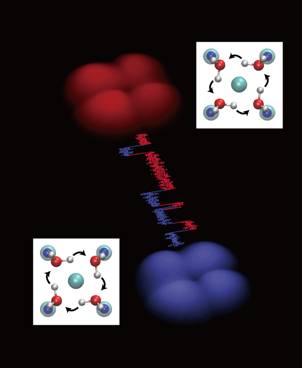Proton transfer through the hydrogen bond plays an essential role across an
incredibly broad spectrum of physics, chemistry and biology. The mystery of
proton dynamics mainly arises from the nuclear quantum effect such as quantum
tunneling due to the small mass of proton. Moreover, the tunneling of protons
within the H-bonded network tends to involve many hydrogen bonds simultaneously,
leading to correlated many-body tunneling. However, the direct evidence of such
concerted proton tunneling still remains elusive, in spite of tremendous
experimental and theoretical efforts for decades.
Recently, the teams led by Prof. Ying Jiang and Prof. Enge Wang of
International Center for Quantum Materials (ICQM) of Peking University report
the use of a cryogenic scanning tunneling microscope (STM) to directly visualize
the concerted proton tunneling within a hydrogen-bonded cyclic water tetramer
adsorbed on NaCl(001) surface.
“This is made possible by monitoring in real time the reversible
interconversion of the hydrogen-bonding chirality of the water tetramer based on
a unique orbital imaging technique, which was newly developed by our groups last
year [see Nat. Mater. 13, 184 (2014)],” says Jiang.
“Another key step is using a chlorine-functionalized STM tip to tune the
tunneling barrier through tip-proton coupling such that the tunneling events can
be readily detectable,” adds Jiang.
Detailed control experiments combined with state-of-the-arts density
functional theory calculations confirm the quantum nature of the proton transfer
between the water molecules. Strikingly, it was revealed that the proton
tunneling process involves a concerted motion of four protons, which are locked
and move in a fully correlated manner as a delocalized quasiparticle.
“The concerted tunneling of protons is extremely sensitive to the coupling
with atomic-scale environment due to the demanding phase coherence between the
protons,” emphasizes Jiang. The researchers found that the Cl-terminated tip can
either enhance or suppress the concerted tunneling process depending on the
details of coupling symmetry between the Cl and the protons.
This work not only sheds new light on the understanding of phase transition
in ices of high-pressure phases and hydrogen-bonded ferroelectric materials, but
also opens a new route for controlling the quantum states of the protons with
atomic scale precision.
Research was published online in Nature Physics on Feb. 16, 2015 (Nat. Phys.
doi:10.1038/nphys3225) and also featured in “News and Views” (Nat. Phys.
doi:10.1038/nphys3269). This work received supports from Ministry of Science and
Technology of China, National Natural Science Foundation of China, Ministry of
Education of China, and National Program for Support of Eminent Professionals.

|
Figure: Chirality switching of a water tetramer. The two different
chiral states (blue and red) arise from the concerted quantum tunneling
of four protons. The switching dynamics can be monitered by recording
the time-dependent current trace using a scanning tunneling microscope.
|
